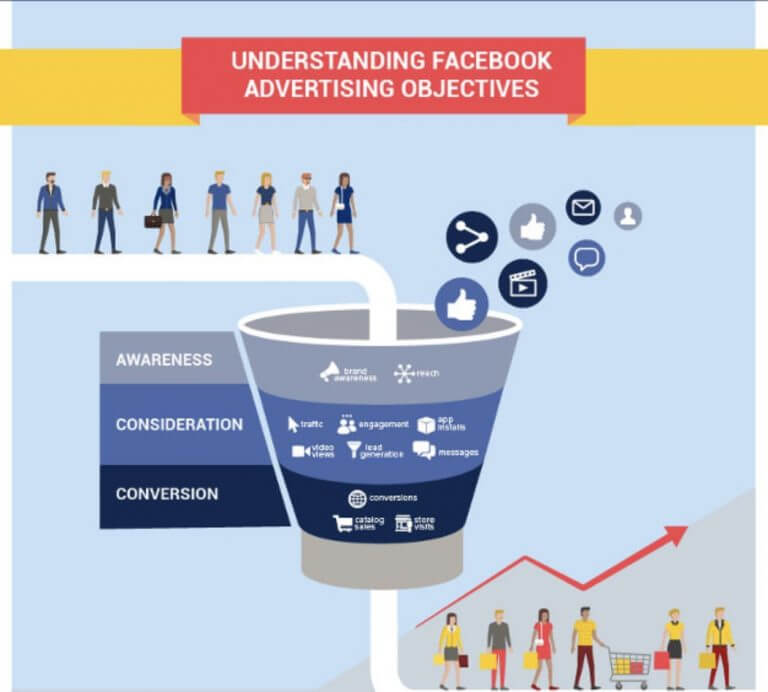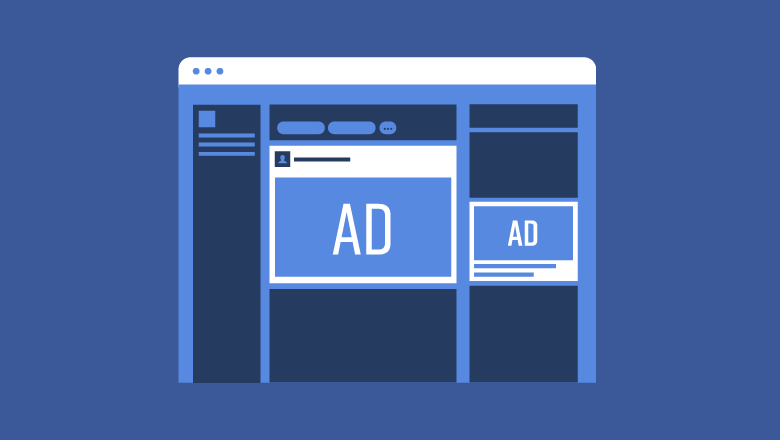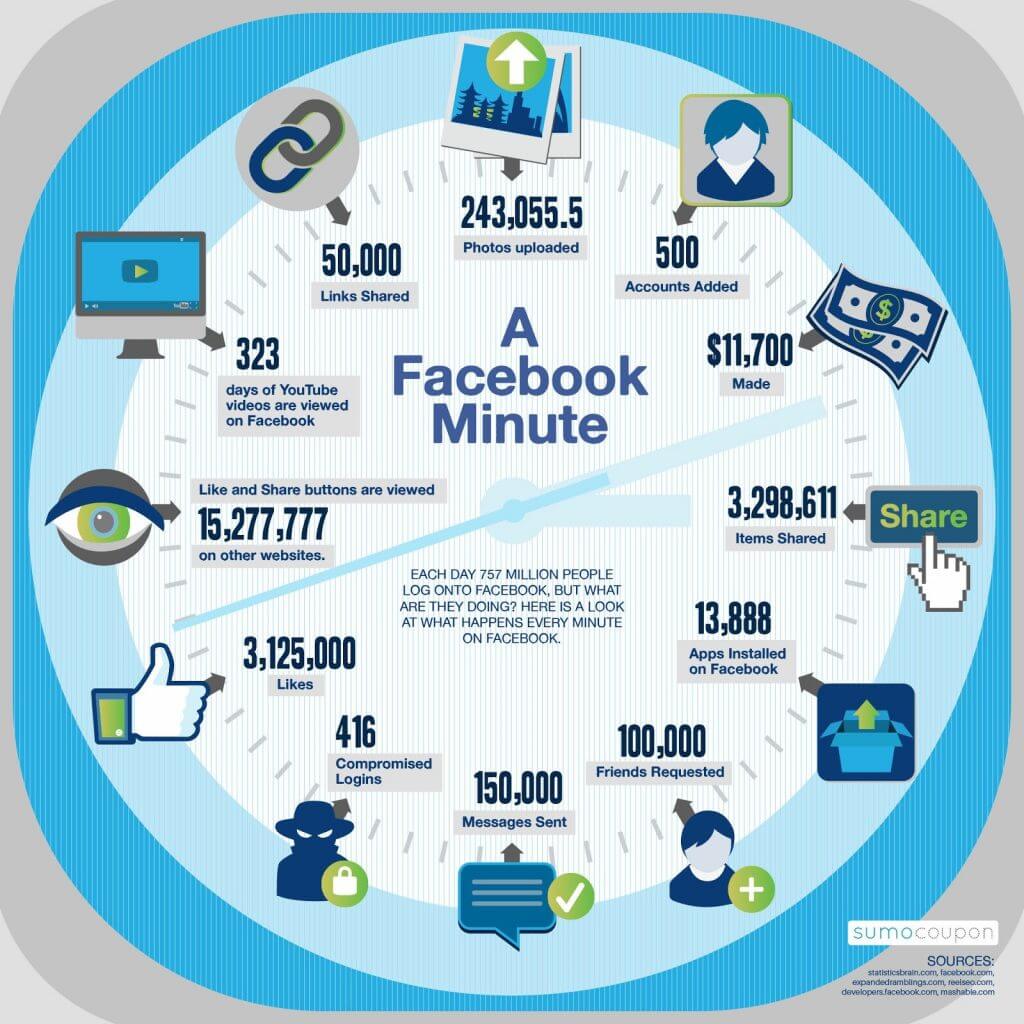Should you pay attention?
The options for modern-day marketing are endless. Video content, guerrilla campaigns, email marketing; it’s easy to get swept away by the never-ending choices. To succeed in your marketing efforts, you need to focus your time, strategy, and budget into the areas that have the most significant impact and audience.
Right now, that area is Facebook Ads.
Digital marketing spend now accounts for an impressive
51% of total advertising spend in the US and in a recent survey, 78% of American consumers say they’ve discovered products on Facebook.
Create Remarketing Campaigns
Remarketing is a classic marketing tactic for catching people who already interacted with your business, but haven’t converted to paying customers. It’s also relevant when you want previous customers to return for repeat purchases. To succeed, you need to use data to track people who visit your site, and monitor which actions they carry out. Then you’ll apply that data to refine your Facebook ad targeting.
For example, someone might add products to their cart, but then leave the site without checking out. Remarketing campaigns plug that data into Facebook to show a specific ad only to people who have abandoned a cart, reminding them to complete their purchase. Or you might have a product, like in B2B, that requires a longer sales cycle, so leads investigated your product, and then went on to compare other potential vendors before coming to a decision. If they regularly see your ad, they’re more likely to choose your business when they finally make a purchase.
However, remarketing campaigns can be complicated to set up. After installing the Facebook pixel on your site, you’ll need to implement a code snippet to capture custom events, like if someone has watched a video in full, subscribed to your email newsletter, or added a product to their cart. If you feel a bit insecure about editing your site’s code, you can use a web analytics tool like Oribi which simplifies the entire process. It lets you define which events you’d like to track and then export them directly to your Facebook ad account, without needing any code or techie knowledge.

Defined Target Audience
Previously, we’ve discussed how to define your target audience on Facebook, and that’s because it’s an integral part of any Facebook ad campaign. Whether it’s demographics like behaviors, interests, connections, or location, Facebook lets you get picky with targeting. You can then layer the options to ensure your ads get shown to your perfect niche audience.
When it comes to the fitness industry, remember that as a studio, health club, or gym: your target audience already has a specific pain point. Weight-loss, toning up, the desire to generally live a healthier lifestyle; whichever fitness niche this audience wants, your brand offers the solution.
If you’ve tried and failed with Facebook ads in the past, you need to assess where you may have gone wrong. Was it with exploring and targeting demographics? While the intricacies of Facebook’s targeting options are endless; if you’re new to Facebook advertising, it’s easy enough to start with the basics. Think age, location, and interests. Using location as an example; say your ads were served to an entire country, but only 1% of that audience found your content relevant. The budget or ad spend may have been high, but your conversion rate will have been low.
When you create a Facebook ad campaign, one of the first things you should know is who you want to see your ads. Who doesn’t know your brand yet, but would want to? Get a crystal clear idea of your target member in mind and tailor your content specifically to them.
Say you’re a spin studio based in South West London; again we’ll use location to demonstrate how to make sure your ad is targeted well.
Understanding How Different Industries Succeed with Facebook Ads
It’s not easy to narrow down the industries that have the most success on Facebook. There are a lot of examples of brands within certain industries that have been successful with Facebook Ads (and plenty more that haven’t), and Facebook has a number of industries that it says their ads can help with.
According to Entrepreneur, 38% of sales come from favoriting or sharing, particularly when a favorited or shared post alerts the soon-to-be buyer of a deal or sale. The product categories that are most socially-referred on Facebook are tech and electronics (25%), beauty and clothing (22%) and food and drink (14%). The other 39% is made up of art, design, DIY, and photo; gardening and décor; and a generic “Other” category.
This graph may also help – it shows the average CTR in Facebook ads across a number of industries. The legal industry seems to do the best, while the employment and job training industry does the worst.
In general, Facebook is best for direct response marketing, which means you’ll encourage your audience to take action right now and they’ll get something for it in return. For example, you have an app that you want customers to download, so you run a Facebook Ad with an exclusive offer that gives people one month of access for free.
Basically, if your business has something your audience can do online right now (downloading an e-book, making a purchase, booking a hotel room), Facebook Ads could definitely help, regardless of your industry.

Tell Compelling Stories
It’s vital to make your ads as engaging as possible. That means that you need to stop thinking as though flyers or billboards have been transferred to the computer screen, and start thinking about drawing leads into your storytelling.
Facebook and Instagram story ads bring this to its peak. You can use either video or a carousel of images to tell an appealing narrative that sparks the interest and imagination of your audience, and then invite the viewer to swipe up on a call-to-action to reach your landing page.. Although these are only short snippets of ads, given that photos show for 6 seconds and videos play for up to 15 seconds, you can pack a lot into them. 57% of brands agree that story ads have been either “somewhat” or “very” effective as part of their marketing campaigns.
If you’re just getting started, our team of experts help you make appealing Facebook story ads quickly and easily. You can use the rich array of templates and combine them with animation, stock video clips, stickers, and more to customize them into effective video ads.

Strategy with Clear-Cut Goals
Having a plan with clear goals and objectives is crucial for any marketing campaign. It allows you to track and monitor content performance and tweak ads when necessary. So, before you even open your Ads Manager, ask yourself 3 questions:
- What is your campaign objective
- Who is your target audience
- How will you measure the results
For example, let’s say that your objective is to raise brand awareness for your studio. Firstly, you want to define your audience. As mentioned earlier, you can initially focus this on basic demographics such as location, age, and interest if you’re new to Facebook ads.
Follow the steps to set up your ad and make sure to optimize your campaign for the website and video clicks. Selecting this optimization will expand your reach and in turn, increase brand awareness. Try to promote the content to the largest defined audience possible; you want the content to be relevant to viewers and also to be seen by a lot of people.
If you’re just getting started with this particular goal for your Facebook ads, it’s a good idea to try out carousel ads. A Kinetic Social study shows that carousel ads have up to 10x higher CTR than static sponsored posts on Facebook. It’s also worth noting that
people look at video content on Facebook 5x longer than a static post. From these statistics, it’s safe to say that you should test a few different types of ad content to see what your audience responds best to. And to veer away from completely static content!
Dedicating the Time it Takes to Handle Facebook Marketing
According to Manta, a majority of small businesses are spending one hour or less focused on Facebook marketing every week.
There’s a lot going on – a lot of competition and a lot of consumers making decisions. If you’re on Facebook infrequently, you’re not going to have a chance at standing out from the rest.
Yes, Facebook marketing is partly automated. You set up an ad, decide when it’s going to run and how much you want to spend, and then leave it.
However, there’s a lot more to Facebook marketing than just creating ads. And ads themselves take a lot of time to think about, create, set target audiences for, run and analyze. On top of that, you have to post at least once per day to Facebook, and some of those posts should be curated from your audience or industry, which means you have to keep an eye on what your community is doing.
We haven’t even mentioned responding to messages or notifications from your audience. If you can do all of that effectively, in an hour or less a week, then you should be teaching us your secrets.
Social media shouldn’t be an afterthought, especially when it comes to the ads you’re pouring your hard-earned money into. If you can only give it enough attention so that it remains in afterthought status, it may be time to outsource it.
The last tip
The creating-testing loop really never ends. Your business is changing, and so is the industry and your audience. We like to change along with them. We’re constantly looking at your data to make sure we understand where your customers are right now. We’ll create content as needed, based on what’s returning great results, what’s under-performing, and how your audience is transforming.
We learn everything you need to know about your customers, like who they are, what makes them click a link and why they need your product. We’re going to know your customers better than they even know themselves, and then we’re going to reach them where they already are: on social.
